A Hundred Holocausts: An Insider’s Window Into U.S. Nuclear Policy
The document in his hand was almost unthinkable: It projected roughly 600 million deaths in a US-Soviet war Here’s the first installment of a memoir of the nuclear era by Daniel Ellsberg, the man who revealed the Pentagon PapersThe document in Daniel Ellsberg’s hand projected roughly 600 million deaths in a U.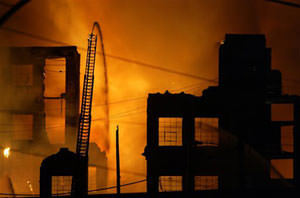
Editor’s note: This is the first installment of Daniel Ellsberg’s personal memoir of the nuclear era, “The American Doomsday Machine.” The online book will recount highlights of his six years of research and consulting for the Departments of Defense and State and the White House on issues of nuclear command and control, nuclear war planning and nuclear crises. It further draws on 34 subsequent years of research and activism largely on nuclear policy, which followed the intervening 11 years of his preoccupation with the Vietnam War. Subsequent installments also will appear on Truthdig. The author is a senior fellow of the Nuclear Age Peace Foundation.American Planning for a Hundred Holocausts
One day in the spring of 1961, soon after my 30th birthday, I was shown how our world would end. Not the Earth, not—so far as I knew then—all humanity or life, but the destruction of most cities and people in the Northern Hemisphere.
What I was handed, in a White House office, was a single sheet of paper with some numbers and lines on it. It was headed “Top Secret—Sensitive”; under that, “For the President’s Eyes Only.”
The “Eyes Only” designation meant that, in principle, it was to be seen and read only by the person to whom it was explicitly addressed, in this case the president. In practice this usually meant that it would be seen by one or more secretaries and assistants as well: a handful of people, sometimes somewhat more, instead of the scores to hundreds who would normally see copies of a “Top Secret—Sensitive” document.
Later, working in the Pentagon as the special assistant to the assistant secretary of defense, I often found myself reading copies of cables and memos marked “Eyes Only” for someone, though I was not that addressee, nor for that matter was my boss. And already by the time I read this one, as a consultant to the Office of the Secretary of Defense, it was routine for me to read “Top Secret” documents. But I had never before seen one marked “For the President’s Eyes Only,” and I never did again.
The deputy assistant to the president for national security, my friend and colleague Bob Komer, showed it to me. A cover sheet identified it as the answer to a question President John F. Kennedy had addressed to the Joint Chiefs of Staff a week earlier. Komer showed it to me because I had drafted the question, which Komer had sent in the president’s name.
The question to the JCS was: “If your plans for general [nuclear] war are carried out as planned, how many people will be killed in the Soviet Union and China?”
Their answer was in the form of a graph (see representation below). The vertical axis was the number of deaths, in millions. The horizontal axis was time, indicated in months. The graph was a straight line, starting at time zero on the horizontal—on the vertical axis, the number of immediate deaths expected within hours of our attack—and slanting upward to a maximum at six months, an arbitrary cutoff for the deaths that would accumulate over time from initial injuries and from fallout radiation.
The lowest number, at the left of the graph, was 275 million deaths. The number at the right-hand side, at six months, was 325 million.
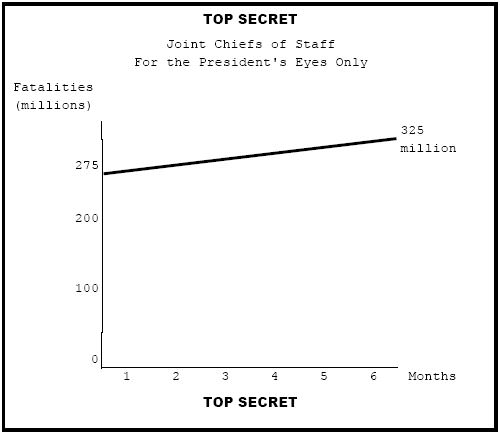
That same morning, with Komer’s approval, I drafted another question to be sent to the Joint Chiefs over the president’s signature, asking for a total breakdown of global deaths from our own attacks, to include not only the whole Sino-Soviet bloc but all other countries that would be affected by fallout. Again their answer was prompt. Komer showed it to me about a week later, this time in the form of a table with explanatory footnotes.
In sum, 100 million more deaths, roughly, were predicted in East Europe. There might be an additional 100 million from fallout in West Europe, depending on which way the wind blew (a matter, largely, of the season). Regardless of season, still another 100 million deaths, at least, were predicted from fallout in the mostly neutral countries adjacent to the Soviet bloc or China: Finland, Austria, Afghanistan, India, Japan and others. Finland, for example, would be wiped out by fallout from U.S. ground-burst explosions on the Soviet submarine pens at Leningrad. (The total number of “casualties”—injured as well as killed—had not been requested and was not estimated; nor were casualties from any Soviet retaliatory strikes.)
The total death toll as calculated by the Joint Chiefs, from a U.S. first strike aimed primarily at the Soviet Union and China, would be roughly 600 million dead. A hundred Holocausts.
* * *
I remember what I thought when I held the single sheet with the graph on it. I thought, this piece of paper should not exist. It should never have existed. Not in America. Not anywhere, ever. It depicted evil beyond any human project that had ever existed. There should be nothing on Earth, nothing real, that it referred to.
But I knew what it dealt with was all too real. I had seen some of the smaller bombs myself, H-bombs with an explosive yield of 1.1 megatons each—equivalent to 1.1 million tons of high explosive, each bomb half the total explosive power of all the bombs of World War II combined. I saw them slung under single-pilot F-100 fighter-bombers on alert at Kadena Air Base on Okinawa, ready to take off on 10 minutes’ notice. On one occasion I had laid my hand on one of these, not yet loaded on a plane. On a cool day, the smooth metallic surface of the bomb was warm from the radiation within: a bodylike warmth.
I was in Okinawa in the fall of 1959 as part of a task force organized by the Office of Naval Research, which was there to study and improve nuclear command and control for the commander in chief of the Pacific Command (CINCPAC), Adm. Harry D. Felt. I was on loan from the RAND Corp., which I had joined as a full-time employee in June 1959 after a previous summer there as a consultant. This particular study took us to every command post in the Pacific that year and the next—from Oahu to Guam, Tokyo, Taiwan and the command ship of the Seventh Fleet—with license from Adm. Felt to “talk to anyone, see anything” in the field of nuclear command and control. At Kadena, the pilots weren’t in the planes on alert or in the hut on the alert strip; they were allowed to be elsewhere, at the post exchange or in their quarters, because each was accompanied at all times by his individual jeep and driver to return him in minutes to the strip when an alert was sounded. They practiced the alert at least once a day. The officer in charge told our research group that we could choose the time for that day’s rehearsal. When our leader said “OK, now,” the klaxons sounded all over the area and jeeps appeared almost instantly on all the roads leading to the strip, rushing around curves, pilots leaping out as they reached the strip and scrambling into the cockpits, still tightening their helmets and gear. Engines started in 10 planes, almost simultaneously. Ten minutes.
These were tactical fighter-bombers, with limited range. There were more than a thousand of them, armed with H-bombs, in range of Russia and China on strips like this or on aircraft carriers surrounding the Sino-Soviet bloc (as we still thought of it in 1961, though China and the Soviets had actually split apart a couple of years before that). Each of them could devastate a large city with one bomb. For a larger metropolitan area, it might take two. Yet the Strategic Air Command (SAC), which did not command these planes (they were under the control of theater commanders), regarded these tactical theater forces as so vulnerable, unreliable and insignificant as a factor in all-out nuclear war that SAC planners had not even included them in their calculations of the outcome of attacks in a general war until that year.
Before 1961, planners at SAC headquarters took into consideration only attacks by the heavy bombers, intermediate-range ballistic missiles and ICBMs commanded by SAC, along with Polaris submarine-launched missiles. In the bomb bays of the SAC planes were thermonuclear bombs much larger than those I saw in Okinawa. Many were from five to 20 megatons in yield. Each 20-megaton bomb—1,000 times the yield of the fission bomb that destroyed Nagasaki—was the equivalent of 20 million tons of TNT, or 10 times the total tonnage the U.S. dropped in World War II. Some 500 bombs in the arsenal each had the explosive power of 25 megatons. Each of these warheads had more power than all the bombs and shells exploded in all the wars of human history.
These intercontinental bombers and missiles had come to be stationed almost entirely in the continental U.S., though they might be deployed to forward bases outside it in a crisis. A small force of B-52s was constantly airborne. Many of the rest were on alert. I had seen a classified film of an incredible maneuver in which a column of B-58s—smaller than B-52s but still intercontinental heavy bombers—taxied down a runway and then took off simultaneously, rather than one at a time. The point—as at Kadena and elsewhere—was to get in the air and away from the field as fast as possible, on warning of an imminent attack, before an enemy missile might arrive. In the time it would normally have taken for a single plane to take off, a squadron of planes would be airborne, on its way to assigned targets.
In the film these heavy bombers, each as big as an airliner, sped up in tandem as they raced down the airstrip, one behind the other so close that if one had slackened its pace for an instant the plane behind, with its full fuel load and its multiple thermonuclear weapons, would have rammed into its tail. Then they lifted together, like a flock of birds startled by a gunshot. It was an astonishing sight; it was beautiful.
The planned targets for the whole force included, along with military sites, every city in the Soviet Union and China.
On carriers, smaller, tactical bombers would be boosted on takeoff by a catapult, a kind of large slingshot. But since the general nuclear war plan, as I knew, called for takeoff around the world of as many U.S. planes and missiles as were ready at the time of the execute order—as near-simultaneously as possible—to attack targets that were all assigned in prior planning, the preparations contemplated one overall, inflexible global attack as if all the vehicles, with more than 3,000 warheads, were launched by a single catapult. A sling made for Goliath.
The rigidity of the single, coordinated plan—which by 1961 included tactical bombers—in what was termed the Single Integrated Operational Plan, or SIOP, meant that its underlying “strategy” amounted to nothing more than a vast trucking operation to transport thermonuclear warheads to Soviet and Chinese cities and military sites. The latter were the great majority of targets, since all the cities could be destroyed by a small fraction of the attacking vehicles.
One of the principal expected effects of this plan—partly intended, partly (in allied, neutral and “satellite” countries) unavoidable “collateral damage”—was summarized on the piece of paper I held that day in the spring of 1961: the extermination of over half a billion people.
(In fact, this was certainly a vast underestimate of the fatalities. Dr. Lynn Eden, a scholar at Stanford’s Center for International Security and Cooperation, has revealed in “Whole World on Fire” (Cornell, 2004) the bizarre fact that the war planners of SAC and the Joint Chiefs have—throughout the nuclear era, to the present day—deliberately omitted entirely from their estimates of the destructive effects of U.S. or Russian nuclear attacks the effects of fire. They have done so on the grounds that these effects are harder to predict than the effects of blast or fallout on which their estimates of fatalities are exclusively based. Yet the firestorms caused by thermonuclear weapons are known to be predictably the largest producers of fatalities in a nuclear war! Given that for almost all strategic nuclear weapons the damage radius of firestorms would be two to five times the radius destroyed by blast, a more realistic estimate of the fatalities caused directly by the planned U.S. attacks would surely have been double the figure on the summary I held in my hand—a billion people or more.)
The declared intent of this planning deployment and rehearsal was to deter Soviet aggression. I knew by this time something that was rarely made clear to the American public, that what was to be deterred by all this was not only nuclear attacks by the Soviets but conventional, non-nuclear Soviet aggression, in Europe in particular. In both cases, the story went, it was all designed to prevent such Soviet attacks from ever taking place. This global machine had been constructed in hopes that it would never be set in motion: or, as it was often put, so that it would never be used. The official motto of SAC, on display at all its bases, was “Peace Is Our Profession.” Deterring Soviet non-nuclear aggression in Europe—say, a military occupation of West Berlin—depended ultimately on a presidential commitment to direct, if necessary, a U.S. nuclear first strike on the Soviet Union. SAC’s profession would shift near-instantaneously from Peace to War. The Strategic Air Command trained daily, and effectively, to be ready to carry out that order. The American commitment to defend NATO (with Berlin its most vulnerable element) by nuclear threats, and if necessary by strategic first-strike nuclear attacks, effectively passed the trigger for such U.S. attacks to the Soviets.
The real possibility that the Soviets might pull that trigger lay at the heart of all our nuclear planning and preparations. It was understood that although deterrence was the principal objective of our nuclear posture, it was not foolproof. It might fail. That applied both to deterrence of nuclear attack and to deterrence of a conventional Soviet attack in Europe. In either case, it was not impossible that the Soviets would attack despite our threats and our best efforts to dissuade them.
What to do then was a matter of highly classified discussion over the years. But on this question the official top-secret plans approved by President Dwight D. Eisenhower were unequivocal: the demolition of the Sino-Soviet bloc.
A striking and highly secret characteristic of the existing plans was that they called for essentially the same strategic response and targeting list for each of three quite distinct ways in which general war might come about. The first, and most likely in the judgment of the JCS, was a U.S. nuclear first strike as an escalation of conflict between U.S. and Soviet conventional forces, perhaps originating in conflict over Berlin or an uprising in East Europe. Second was U.S. pre-emption of an imminent Soviet nuclear attack on the U.S., or as I’d heard it described in the Pentagon, “striking second first.” Third—and least likely in the eyes of the JCS—was a retaliatory response to a successful Soviet surprise attack.
Although the size of the U.S. force available for attack would be different in each of these cases, the Eisenhower-approved plans called for the same target list—which included 151 “urban-industrial targets,” i.e. cities, along with military targets—to be attacked under all conditions.
The circumstances of war initiation, by determining the size of the force, would influence only the amount of coverage of the target list. Initial attacks would be as massive and as nearly simultaneous in arrival as possible. Attacks by all nonalert forces would follow as quickly as they could be launched. No forces would deliberately be held in reserve: an arrangement perhaps unique in the history of war planning.
And in all three cases, all large cities of both the Soviet Union and China (even if China had no part in the crisis or hostilities triggering execution of this plan) were high on the list for initial, simultaneous missile attacks, and for subsequent coverage by bombers—along with the highest-priority Soviet missile sites, air bases, air defenses and command centers.
In the White House in January 1961 I had informed the newly arrived assistant to the president for national security, McGeorge Bundy, of a number of little-known facts and problems. (How I came to this knowledge will be recounted later in this series.) One of these was the focus on U.S. first-strike plans in American preparations for any conflict with the Soviet Union involving forces above the level of a brigade. Another was Eisenhower’s approval of operational planning to destroy an “optimum mix” of population targets along with military sites no matter how the conflict had originated.
A third subject in my briefing was the variety of ways in which the strategic forces might be triggered “by accident”: by false alarm, miscalculation, miscommunication, or actions not directly authorized by the president or perhaps by any high-level commander. (Exploring these possibilities in the field had been my special mission in the CINCPAC task force, and later as a RAND specialist in nuclear weapons “command and control.”)
The last point in particular caught Bundy’s attention. I reported what I had learned in the Pacific, one of the most sensitive secrets in the system: that to forestall the possibility that our retaliatory response might be paralyzed either by a Soviet attack on Washington or by presidential incapacity, President Eisenhower had as of 1958 secretly delegated to theater commanders the authority to launch nuclear operations in a crisis, either in the event of the physical unavailability of the president—Eisenhower himself had suffered both a stroke and a heart attack in office—or if communications with Washington were cut off.
I had further learned that CINCPAC, Adm. Felt, had likewise delegated that authority downward in his command, under like conditions. That put many fingers on the button if communications went out between Washington and Hawaii, or Hawaii and the Western Pacific. In those years such an outage occurred for each of these links, on average, once a day. Thus this arrangement magnified greatly the possibilities listed above for “inadvertent, accidental” nuclear war, especially when outages occurred during a potential nuclear crisis such as the Taiwan Straits (Quemoy) confrontation of 1958. (The response of the Kennedy and Johnson administrations to this information will be addressed in my next installment.)
The combined message of these reports was that our overall system for strategic response had the character of a giant thermonuclear mousetrap on a hair trigger. For a wide variety of provocative circumstances—definitely not requiring and most not involving either Soviet-initiated nuclear attacks or imminent expectation of them—it was set inflexibly to annihilate a large fraction of the civilian population of the Soviet Union and China, and of many allies and neutrals.
My one-on-one briefing of Bundy in his first weeks in office—arranged by Paul Nitze, the assistant secretary of defense for international security affairs—was in part the reason I was in a position to draft questions for the White House soon after. As it happened, I had drafted the question about estimated deaths from execution of the general war plans in the belief that the JCS did not know an answer to it. Officers I worked with in the planning staff of the Air Force were convinced that no one, either in the Joint Staff or the Air Staff, had ever calculated the overall human consequences of carrying out their plans. That encouraged me to ask the JCS in the name of a higher authority for an estimate, in the expectation they would be embarrassed by having to admit they could not answer it promptly. The authority I had in mind initially was the secretary of defense. (Although funding for RAND, including my salary, came mainly from the Air Force at that time, I was in effect on loan to the Office of the Secretary of Defense for much of 1961.) But as I’ve said, the question was picked up by the White House and sent in the president’s name. I had deliberately limited it, initially, to effects in the Soviet Union and China alone, instead of worldwide or in the Sino-Soviet bloc. That was to keep the Joint Staff from disguising its lack of any estimates at all by pleading a need for time to calculate casualties, say, in Albania, or the Southern Hemisphere.
Alternatively, I expected the Joint Staff to improvise an estimate which could easily be exposed, to its embarrassment, as unrealistically low. The point of eliciting either of these expected responses was to gain bargaining power for the secretary of defense in a bureaucratic effort (discussed later) to change the JCS plans in the direction of guidance I had drafted for the secretary earlier that month.
But my expectations were wrong. The Joint Chiefs were embarrassed neither by the question nor by their answer. That was the surprise, along with the answer itself. The implications, as I saw them, were literally existential, bearing on the nature and future of our species.
I myself at that time was neither a pacifist nor a critic of the explicit logic of deterrence or its legitimacy. On the contrary, I had been urgently working with my colleagues to assure a survivable U.S. capability to threaten clearly unacceptable damage to the Soviet Union in response to the most successful possible Soviet nuclear attack on the U.S. But planned slaughter of 600 million civilians—10 times the total death count in World War II, a hundred times the scale of the Holocaust? That aimed-for accomplishment exposed a dizzying irrationality, madness, insanity, at the heart and soul of our nuclear planning and apparatus.
I said earlier that I saw that day how the northern civilized world would end. I might have thought instead how it could end or might do so, but that wasn’t the conclusion I drew then. The chart I held in my hand that spring morning said to me that any confidence—worse, it seemed, any realistic hope—that the alert forces on either side might never be used was ill-founded.
The Americans who had built this machine, knowing, it turned out, that it would kill more than half a billion people if it were turned on—and who were unabashed in reporting this to the president—humans like that would not fail to pull the switch if ordered to do so by a president, or, as I mentioned above and will discuss in the next installment, possibly by a superior other than the president.
And the presidents themselves? A few months earlier, Dwight Eisenhower had secretly endorsed the blueprints of this multi-genocide machine. He had furthermore demanded largely for budgetary reasons that there be no other plan for fighting Russians. He had approved this single strategic operational plan despite reportedly being, for reasons I now understood, privately appalled by its implications. And the Joint Chiefs had responded so promptly to his successor’s question about the human impact of our planned attacks because they clearly assumed that John Kennedy would not, in response, order them to resign or be dishonorably discharged, or order the machine to be dismantled. (In that, it turned out, they were right.)
Surely neither of these presidents actually desired ever to order the execution of these plans, nor would any likely successor want to take such an action. But they must have been aware, or should have been, of the dangers of allowing such a system to exist. They should have reflected on, and trembled before, the array of contingencies—accidents, false alarms, outages of communications, Soviet actions misinterpreted by lower commanders, unauthorized action—that might release pent-up forces beyond their control; and on possible developments that could lead them personally to escalate or launch a pre-emptive attack.
Eisenhower had chosen to accept these risks. To impose them on humanity, and all other forms of life. Kennedy and Lyndon B. Johnson to my direct knowledge did likewise. So did Richard Nixon. To bring this story up to the present, there is much evidence—and none to the contrary—that the same has been true of every subsequent president.
Two more aspects of their gambles were not known to me in 1961. Later accounts in this series will reveal that in the Quemoy crisis three years earlier and the Cuban missile crisis one year later—and to lesser extent in a couple of dozen other episodes—these risks came secretly closer to being realized than almost anyone recognizes to this day.
Moreover, the scale of the potential catastrophe was and remains vastly greater than I or the JCS or any presidents imagined over the next 20 years. Not until 1982-83 did new calculations—recently confirmed—reveal that hemispheric and possibly global clouds of smoke and soot from the burning cities attacked by U.S. or Russian forces would block out sunlight for a prolonged period, lowering temperature drastically during spring and summer, freezing lakes and rivers and destroying crops worldwide. This “nuclear winter” could extinguish many forms of life and starve to death billions of humans.
Yet the “option” of massive attacks on cities (or, euphemistically, upon industrial and military targets within or near cities) almost surely remains one among many planned alternatives, ready as ever to be carried out, within the strategic repertoire of U.S. and Russian plans and force readiness: this, a quarter-century after the discovery of the nuclear winter phenomenon.
The U.S. and Russia currently each have about 10,000 warheads, over 2,000 of them operationally deployed. (Each has several thousand in reserve status—not covered in recent negotiations—and an additional 5,000 or so awaiting dismantlement). Presidents Barack Obama and Dmitry Medvedev have agreed to lower the operational warheads to between 1,500 and 1,675 by the year 2012. But the explosion of 1,000 warheads together by the U.S. and Russia could trigger a full-scale nuclear winter. And recent studies show the possibility of ecological catastrophe from smoke effects on the ozone layer after a very much smaller exchange, such as could occur between India and Pakistan. A 2007 peer-reviewed study concluded that “the estimated quantities of smoke generated by attacks totaling little more than one megaton of nuclear explosives [two countries launching 50 Hiroshima-size bombs each] could lead to global climate anomalies exceeding any changes experienced in recorded history. The current global arsenal is about 5000 megatons.” A December 2008 study in Physics Today estimates that “the direct effects of using the 2012 arsenals [1,700 to 2,200 Russian and American warheads each] would lead to hundreds of millions of fatalities. The indirect effects [long-term, from smoke] would likely eliminate the majority of the human population.”
It is the long-neglected duty of the American Congress to test these scientific findings against the realities of our secret war plans. It is Congress’ responsibility to investigate the nature of the planned targets for the reduced operational forces proposed by Obama and Medvedev—1,500 to 1,675—or some lower but still huge number like 1,000, and the foreseeable human and environmental consequences of destroying those targets with the attacks currently programmed.
The questions to be addressed initially are simple: “How many cities would burn under our various preplanned ‘options’? How many humans would die from these various attacks—from blast, fire, fallout, smoke, soot and ozone depletion—in the target country, in its regional neighbors, in America, and worldwide?”
And these, less simple: “For each of these possible attack options and exchanges, what is the likely, and the range of possible, impact on the regional and global environment? Which of our options, if any, threaten to produce regional or worldwide nuclear winter? Do we—or does any state—have a right to possess such an ‘option’? Should a U.S. or Russian president have the authority—or the power, as each now has—to order attacks that might have the global effects described above?”
Our representatives in Congress should—for the first time—take on responsibility for learning about and influencing the possible human and environmental consequences of carrying out our operational nuclear war plans. But past experience makes clear that Senate or House members will not hold real investigative hearings, using committee subpoena powers, to penetrate the curtains of secrecy around these matters without a new level of pressure from American citizens. (To join some worthy efforts—which have not heretofore, in my judgment, focused sufficiently on congressional investigation or war planning—see here, here and here.
This is not a responsibility only for Americans and their representatives. The stakeholders directly threatened by the possibility, however unlikely, that Americans and Russians might launch a major fraction of their presently deployed nuclear forces against each other comprise all the citizens of every state on Earth.
Every parliament in the world has an urgent need to know what its constituents have to expect—in the way of homicidal and environmental damage—from a U.S.-Russian nuclear exchange: or for that matter, from an India-Pakistan exchange. These assemblies have a stake in discovering—and changing—the societal and ecological impact of the existent contingency war plans of every nuclear weapons state, the U.S. and Russia above all but the others as well. What is needed is a worldwide movement. Fortunately there are several efforts to join (see here, here, here, here and here), in keeping with President Obama’s declared goal of a world free of nuclear weapons.
I felt sure in 1961 that the existent potential for moral and physical catastrophe—our government’s readiness to commit multi-genocidal extermination on a hemispheric scale by nuclear blast and fallout (no one knew yet of the global danger of ecocide and mass extinctions from smoke and ozone depletion)—was not only a product of aberrant Americans or a peculiarly American phenomenon. I was right. A few years later, after the Soviets were humiliated by the Cuban missile crisis and Nikita Khrushchev was ousted, the Kremlin set out to imitate our destructive capacity in every detail and surpass it when possible.
To be sure, Americans, and U.S. Air Force planners in particular, were the only people in the world who believed that they had won a war by bombing, and, particularly in Japan, by bombing civilians. In World War II and for years afterward, there were only two air forces in the world, the British and American, that could so much as hope to do that.
But the nuclear era put that demonic temptation—to deter, defeat or punish an adversary on the basis of an operational capability to annihilate most of its population—eventually within the reach of a great many nations. By the spring of ’61, four states (soon to be five, now nine) had, at great expense, bought themselves that capability. Humans just like these American planners—and presidents—were surely at work in every nuclear weapons state producing plans like these for nuclear attacks on cities.
I knew personally many of the American planners, though apparently—from the fatality chart—not quite as well as I had thought. What was frightening was precisely that I knew they were not evil, in any ordinary, or extraordinary, sense. They were ordinary Americans, capable, conscientious and patriotic. I was sure they were not different, surely not worse, than the people in Russia who were doing the same work, or the people who would sit at the same desks in later U.S. administrations. I liked most of the planners and analysts I knew. Not only the physicists at RAND who designed bombs and the economists who speculated on strategy (like me), but the colonels who worked on these very plans, whom I consulted with during the workday and drank beer with in the evenings.
That chart set me the problem, which I have worked on for nearly half a century, of understanding my fellow humans—us, I don’t separate myself—in the light of this real potential for self-destruction of our species and of most others. Looking not only at the last eight years but at the steady failure in the two decades since the ending of the Cold War to reverse course or to eliminate this potential, it is hard for me to avoid concluding that this potential is more likely than not to be realized in the long run.
Are further proliferation and—what I have focused on here—the persistence of superpower nuclear arsenals that threaten global catastrophe a near-certainty? Is it too late to eliminate these dangers, in time? Some dark days I think so, as I did that morning in the White House. Most of the time I don’t, or I would not have tried as I have and still do to eliminate them, and I would not be using my time to begin this account of them.
The story does get worse; see, for example, my next installment, “How Many Fingers on the Buttons?” The more one learns about the hidden history of the nuclear era—this is the cumulative message of this ongoing series—the more miraculous it seems that the doomsday machines which we and the Russians have built and maintained have not yet triggered each other. At the same time, the clearer it becomes that we could and that we must dismantle them.
Your support matters…Independent journalism is under threat and overshadowed by heavily funded mainstream media.
You can help level the playing field. Become a member.
Your tax-deductible contribution keeps us digging beneath the headlines to give you thought-provoking, investigative reporting and analysis that unearths what's really happening- without compromise.
Give today to support our courageous, independent journalists.

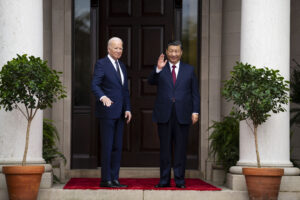
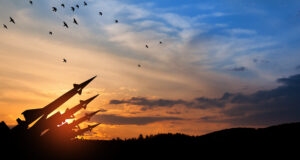

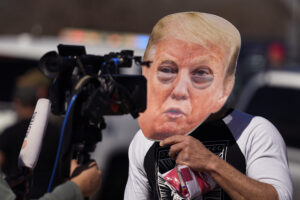
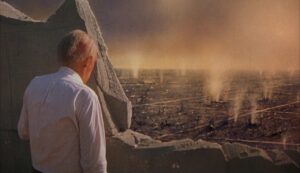



You need to be a supporter to comment.
There are currently no responses to this article.
Be the first to respond.